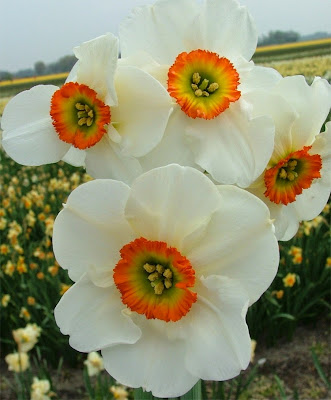Type of Flower
Narcissus Poeticus:
Narcissus Poeticus (Poet's Daffodil, Nargis, Pheasant's Eye, Findern Flower, and Pinkster Lily) was one of the first daffodils to be cultivated, and is frequently identified as the narcissus of ancient times often associated with the Greek legend of Narcissus.Extremely fragrant, with a ring of petals in pure white and a short corona of light yellow with a distinct reddish edge,Poet's Daffodil grows to 20 to 40 cm (7.9 to 15.7 in) tall and is widely naturalized in North America and Europe.
Narcissus all parts of the plant are poisonous, the bulb is the most toxic.Poet's Daffodil is more dangerous than others, acting as a strong emetic and irritant.The scent is powerful enough that it can cause headache and vomiting if a large quantity is kept in a closed room.
It contains lycorine, an alkaloid known for its ability to induce vomiting and gastrointestinal cramping. The American Society for the Prevention of Cruelty to Animals (ASPCA) includes it among its list of plants toxic to cats and dogs. Symptoms of poisoning in animals include diarrhea, vomiting, salivation and, in extreme cases, convulsions and cardiac arrhythmias.
Toxicity is not limited to animals, however. In the majority of documented cases, narcissus bulbs were mistaken for onions. In May 2009, a group of children from Gorseland Primary School in Suffolk, England, harvested onions from their school garden that were to be added to a recipe for a cooking class. A narcissus bulb found its way into the soup and wasn’t discovered until several of the children began vomiting while others complained of stomach cramps. Twelve children were taken to hospital and released later that day.
Poet's Daffodil is cultivated in the Netherlands and southern France for its essential oil, narcissus oil, one of the most popular fragrances used in perfumes. Narcissus oil is used as a principal ingredient in 11% of modern quality perfumes—including 'Fatale' and 'Samsara'—as a floral concrete or absolute. The oil's fragrance resembles a combination of jasmine and hyacinth.
Narcissus poeticus has long been cultivated in Europe. According to one legend, it was brought back to England from the crusades by Sir Geoffrey de Fynderne.It was still abundant in 1860 when historian Bernard Burke visited the village of Findern—where it still grows in certain gardens and has become an emblem of the village.It was introduced to America by the late 18th century,when Bernard McMahon of Philadelphia offered it among his narcissus. It may be the "sweet white narcissus" that Peter Collinson sent John Bartram in Philadelphia, only to be told that it was already common in Pennsylvania, having spread from its introduction by early settlers.The plant has naturalized throughout the eastern half of the United States and Canada, along with some western states and provinces.
Narcissus poeticus has long been hybridized with the wild British daffodil Narcissus pseudonarcissus, producing many named hybrids. These older heritage hybrids tend to be more elegant and graceful than modern hybrid daffodils, and are becoming available in the UK once again.
http://en.wikipedia.org/wiki/Narcissus_poeticus
http://www.britannica.com/blogs/2009/11/the-lovely-poisonous-narcissus-toxic-tuesdays-a-weekly-guide-to-poison-gardens/























No comments:
Post a Comment